By Bashaarat Masood, Sofi Ahsan and Mir Ehsan
It’s 16 days now since the killing of Hizbul Mujahideen commander Burhan Muzaffar Wani set off massive street protests across Kashmir. More than 45 are dead, above 2,500 injured, large parts of the Valley remain under curfew, and supplies are running out. But if life must go on, so must these men, some of them thousands of miles from family, others just kilometres away, none able to visit home.
He won’t allow himself to be photographed, nor give his name. “I don’t want people to burn my home in Kupwara,” he says. “Call me by any name but not my original one.” A constable in the J&K Police, he is currently posted as a personal security officer with a superintendent of police. But these days, no hand can be spared, and so he is out on the streets by 7 every morning, among those trying to keep the Valley’s protesters in check.
‘If the aim of protesters is to throw stones, ours is to save lives’
Personal Security Officer, 28
Constable, J&K Police
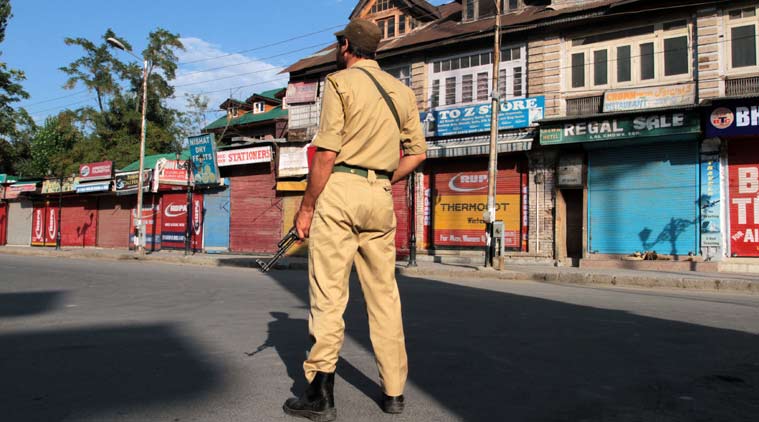 The 28-year-old, deployed as a personal security officer with an SP, says, “Civilians hate us, there is no denying that” (Source: Express photo by Shuaib Masoodi)
The 28-year-old, deployed as a personal security officer with an SP, says, “Civilians hate us, there is no denying that” (Source: Express photo by Shuaib Masoodi)
Every day he ventures out, the constable says, he doesn’t know by when in the night his duty will end.

On most days, he fears what turn it will take. In this latest outburst of anger on the streets of Kashmir, police are at the receiving end. One policeman has been killed and at least 132 police and CRPF personnel have been injured since the protests began.
As he gets ready to leave for work, the constable talks about how he hasn’t been home since July 1. Kupwara, his home town, is just 90 km away, but he can’t risk running into trouble on the way.
The constable joined the force in 2011, and before the protests began, would usually visit home on weekends, after the Friday prayers. Since most Fridays are tense in the Valley, he looked forward to the peaceful ones.
At the SP office where he reports for work, his boss, who doesn’t want to be identified either, asks him whether he could visit home if he left late on Friday. “It could be too dangerous,” the constable replies. “Youths stop you on the streets and ask for identity cards.”
The SP’s office is at the Civil Secretariat, a relatively peaceful area. But the constable must go where the officer goes, and this means he often finds himself in front of stone-throwing protesters.
At such times, the only thing to do is speed away, he says. “Those of us who are part of escort teams have only one AK-47 rifle with us,” he says. However, there have been several instances of protesters being killed in firing by such escort teams.
When he was a civilian, the constable adds, he too thought police were responsible for excesses in the Valley. But when he joined the force, he understood what it meant to be a policeman here, he says. “I saw what is right and wrong, and why a police officer does what he does. I don’t worry about what people think about me as long as I am on the right side and have done no wrong.”
But as the day wears on and he stands alert amidst deserted streets and the curfew, the constable admits he has doubts. The year before he joined police was the year of widespread protests in the Valley, which saw 120 deaths. “There was too much unemployment and yes, if I had an alternative job, perhaps I would have taken that,” he says. “It’s not because of the situation,” he clarifies, “but this is a 24-hour job and it keeps me from home.”
His is traditionally a farmer family, and his brother is a teacher.
When the SP is in his office, the constable eats at the pantry outside. But officially, there are no breaks during the day, he says.
Finally, it’s evening, and another long day is nearing its end. The constable won’t get into the failed politics that has brought Kashmir to an edge again, but sighs that the anger is only self-destructive. “People damage government property and sometimes even hurt locals during protests. They don’t understand that ultimately it is to their own harm. Police do right at their level and still public does not understand us and hates us. We (police) are trained to tolerate and have patience, come what may.”
He knows all the slurs hurled at them, he adds. How can people say police remain unaffected by the deaths of over 45 people and the damage caused to the eyes of over a hundred due to pellet firing, he asks. “Civilians hate us, there is no denying that.”
But as he wraps up, only to come back the next morning, he still has faith, the constable adds. “If it weren’t for people like us in uniform, there would have been problems. There would be many crimes, there would be no stopping them. If the aim of the protesters is to throw stones, ours is to save lives.”
‘These kids are so angry, they may take to streets, lose other eye too’
Dr Rashid Maqbool, 31
Consultant Ophthalmologist, SMHS hospital, Srinagar
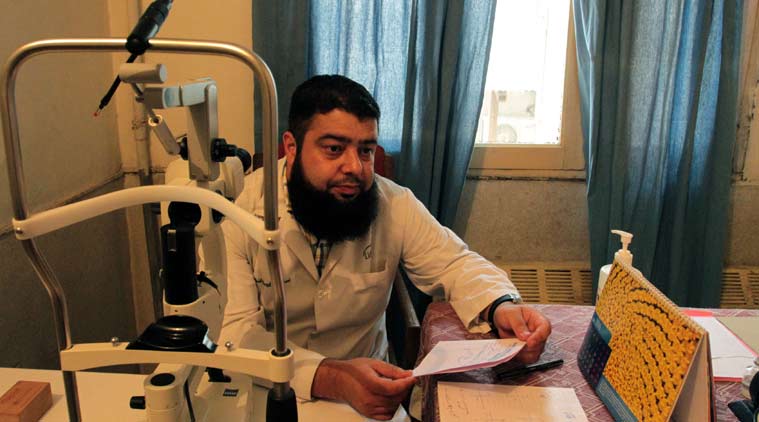 Dr Maqbool says he has not seen his newborn daughter for nearly a fortnight (Source: Express photo by Shuaib Masoodi)
Dr Maqbool says he has not seen his newborn daughter for nearly a fortnight (Source: Express photo by Shuaib Masoodi)
OF THE 25 days since the birth of his daughter, Dr Rashid Maqbool has not seen her for 13. In truth, Maqbool says, with communication networks down, he is in the dark about both mother and daughter, who are away in Shopian. But, he adds, it can’t compare with what some of his patients will have to endure — a lifetime in the dark.
The controversial use of pellet guns by security forces has left at least 137 youths — including 15 children — with eye injuries, and the grim possibility that they could lose vision in one or both eyes. Doctors say that five of them have been blinded while more than 50 are unlikely to regain vision in one eye.
Dr Maqbool is part of the team of doctors at the ophthalmology ward of SMHS Hospital in Srinagar which is treating most of the injured.
There are 11 consultants and eight residents in the department — the only hospital in the Valley with an ophthalmology section.
Over the last 10 days, Maqbool and his colleagues have operated on all the 137 injured patients.
One Sunday, the 31-year-old surgeon says, he and his colleague, Dr Ishfaq Ahmad Sofi, were scheduled to operate on 25 patients in a day. “When we started, we had 10 cases with eye injuries, but as we were operating on the third or fourth injured, we were informed that 20 more cases had arrived,” he says.
“The number kept increasing, and when we finished at 11 in the night, we had spent 12 hours in the operation theatre without a break. We were still not done with the patients but we had to stop as the theatre required fumigation.”
On the second day of the protests itself, Dr Maqbool says, the team conducted 37 eye surgeries, most of them with pellet injuries and a few who had been hit by tear smoke cannisters. He adds that they would hear slogan-shouting every half an hour, signalling that another injured youth had been brought to the hospital.
At one point, Dr Maqbool says, he had an emotional breakdown. “I had stepped out of the theatre for a few minutes when I saw a 25-year-old injured youth. He was being resuscitated by a team of doctors but he succumbed,” he says. “For a few moments, I couldn’t register anything. ‘Should I continue with the surgeries?’, I asked myself,” he says. “But I gathered myself and rushed back to the theatre.”
Dr Maqbool asserts that the current turmoil is different from the previous ones. “I have been taken aback by the amount and intensity of the injuries. It is depressing to say the least,” he says. “Being doctors, we have to keep emotions aside, but there is only so much one can take. We feel disturbed by the pictures and the patients with such grievous injuries.”
And then he has another nagging worry for his patients. “Young children losing an eye is never good, but some of these children are so angry. We fear that they will pick up stones again and lose the other eye too,” he says.
The current crisis has also temporarily split his family. At his home in Peer Bagh, on the outskirts of Srinagar city, his older daughter, who is three, keeps asking him to take her to her mother and newborn sister, who are at his wife’s maternal home in Shopian, some 60 km from Srinagar. Dr Maqbool’s mother has been looking after her while he is in hospital.
“She keeps telling me to take her to Shopian,” the doctor says. “It is difficult these days, and even if I reach there, I may not be able to come back. What will happen to these patients here?”
‘I’m amazed even elderly pelt stones at us. But verbal abuse is the worst’
Parimal Mandal, 45
Head Constable, CRPF
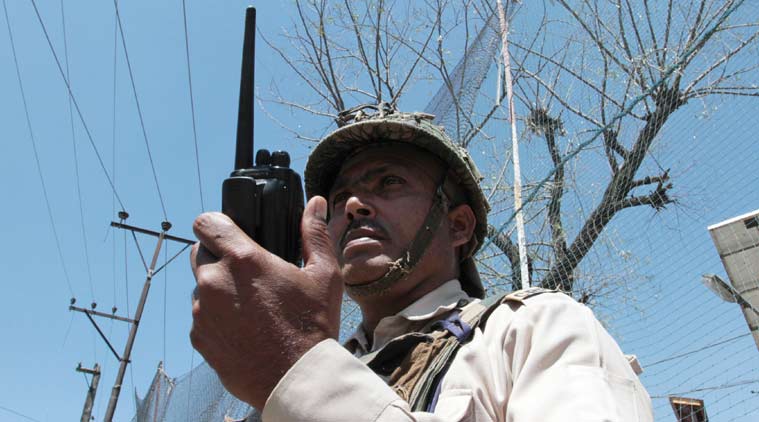 It’s not easy to stand at the same place for 10-12 hrs in the heat, says Mandal (Source: Express photo by Shuaib Masoodi)
It’s not easy to stand at the same place for 10-12 hrs in the heat, says Mandal (Source: Express photo by Shuaib Masoodi)
Home for Parimal Mandal is 2,200 kilometres away at Nadia in West Bengal, but for the past 11 years, the CRPF head constable has been stationed in Kashmir. With Srinagar under curfew, only men in uniform, like Mandal, roam the streets.
“For the last 12 days, I have been deployed at various locations in Old City. The intensity of the stone-pelting was severe for three days, between July 9 and 11, but it has since subsided,” says Mandal, holding his Pump Action Gun that is used to fire tear gas shells.
Every morning around 7 am, Mandal and his team of young jawans leave their camp in a bullet-proof bunker vehicle and head to Eidgah locality, to secure the main highway from the protesters. “It pains me to see young boys, some as young as 7, pelt us with stones,” says Mandal who joined the paramilitary force in 2005.
Despite an extended stint in Kashmir, until now, Mandal has never had to deal with protesters. During the 2008 and 2010 crisis, he was tasked with guarding the Jawahar Tunnel, which links Kashmir to Jammu and is located about 90 km from Srinagar. “My assignment then was to safeguard the tunnel from an attack and had nothing to do with crowd control,” he says.
Over the past few days, Mandal has got accustomed to the stone-pelters’ routines. The intensity of the stone-pelting is at its peak in the morning and in the late evening hours, he says. “My men are most vulnerable in the morning and at the time of withdrawal, close to dusk. As the head of my section, I have to remain alert to guide them.”
He remains in touch with his superior officers over a wireless set. Once stone-pelting begins, he has to provide hourly updates to an officer, stationed 2 km away, at the camp. “Most of the times, if the protesters are in a small group, we chase them with a mild lathicharge. But if there is a big crowd, even tear gas shells don’t deter them,” he says.
Mandal insists that the pellet guns are used as a last option. “We always carry pellet guns with us but use them only when we are unable to control the situation,’’ he says, and believes that many of the youth who indulge in stone-pelting have become immune to tear gas and pepper spray.
The CRPF men deployed in the city work in coordination with the local police, who are familiar with the topography. “Local policeman always come to our rescue when we have to chase away the protesters in the congested lanes and by-lanes of Old City. It is surprising at times that elderly people throw stones at us and pass on information about our location to the stone-pelters.”
For Mandal, the most difficult part is when the protesters indulge in verbal abuse. “As most of my men are young, it becomes difficult to control them when they are being abused. In fact, the protesters abuse only to provoke us.”
As the day wears on, Mandal and his men take turns to eat lunch and have their tea inside their bullet-proof vehicle. “We can never take chances or lower our guard even when there is no stone-pelting. This is the time expert stone-pelters attack.”
Since the start of fresh protests in Kashmir, Mandal says, he has not been able to take rest or sleep properly. “We leave our camp early in the morning and are back only at night. If there is some emergency, we must wear our uniform and riot gear and leave for the trouble spot,” he says.
The lack of communication channels affects the jawans too. “My cellphone is not working and I don’t have access to a landline number, so I have not been able to contact my wife and 16-year-old daughter. My family members must be worried,” he says.
Around 8 pm, the bullet-proof bunker arrives to pick Mandal and his men; he is the last to board. “There has been no casualty or injury in my area today; I thank my stars,” he says, as the vehicle fights its way through a barrage of stones from the lanes and by-lanes. By the time Mandal reaches his battalion headquarters, it is dark. “When I reach the camp, all I want to do is rest, not even eat dinner though I am hungry. It is not easy to stand at one place for 10-12 hours in the sweltering heat. And two-three hours of rest is luxury.’’
‘Afraid my son may get sucked in’
Javed Ahmad Dar, 40
Photojournalist
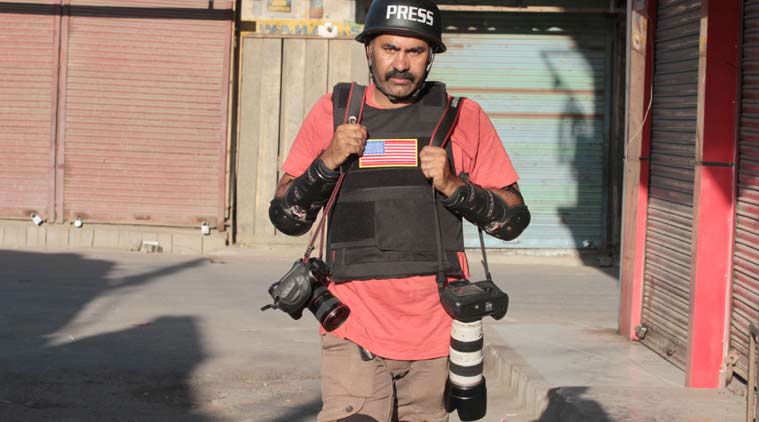 Photojournalists also face public wrath these days, and Dar blames TV channels (Source: Express photo by Shuaib Masoodi)
Photojournalists also face public wrath these days, and Dar blames TV channels (Source: Express photo by Shuaib Masoodi)
Javed Ahmad Dar is sitting in his makeshift office at Srinagar’s press colony when his colleagues barge in. “Let’s rush to SMHS (Shri Maharaja Hari Singh) Hospital. They will bring the injured there,” they tell him. “Protesters have been fired upon at Behramshah (village) in Anantnag. A boy has been killed and several have been injured.”
Javed instinctively reaches for his camera before it dawns on him: the village is just a few hundred metres from his own house. Javed immediately drops his camera and instead reaches for his cellphone. He admits he is afraid for his 17-year-old son and his nephews.
Javed’s village, Muniward at Anantnag in south Kashmir, is the epicentre of the current protests and he fears that his son, Danish Javed, a Class XII student, could get sucked into the crisis. “Whenever I hear about the injured, I think of him. He is of that age and could be in the protests at any time,” he says.
But with the Valley on the boil, communication, as always, is a casualty. Cellular services have been snapped and Javed can’t get through. He is forced to rush to the hospital hoping none of his relatives is among the injured or dead. “This restriction (on cellphones) makes it even more agonising,” he says.
Dar clicks his pictures at the spot and returns to office. The first thing he does is look for a way to contact those few in his village who have BSNL connections, the only line of communication in the Valley these days. After over an hour, he gets lucky. A relative tells him that everyone is fine at home.
“We have the most difficult job,” says Javed, who works for an international wire agency. “If there is an incident somewhere, everybody runs away from it, but we have to run towards it. The job becomes more difficult when you are in a conflict zone. It takes a toll on one’s mental health,” he adds.
These days, with a strict curfew in places and no curfew passes, Javed’s day starts earlier than usual. He says he leaves home at 5 am and reaches his office at around 6 am. “I have to ensure that I reach the press colony before the security forces are deployed and before the protesters take to the roads,” he says.
At 7, he is out again to take pictures of the desolate streets under curfew. He returns to his office to file the pictures before taking his bike out again, through some of the most volatile neighbourhoods of Srinagar. In between, Javed says, if he gets a phone call about a protest, he rushes to the spot, or to a hospital if anybody is injured, passing through hostile security forces and the protesters.
However, photojournalists increasingly have to not only defy curfew but also battle a hostile public, particularly family members of the injured at hospitals.
“The other day, I was at SMHS Hospital and couldn’t take out my camera for several hours due to the crowd. There was a little window during which I took it out of my bag, clicked a few pictures and put it back in. I was lucky nobody found me with a camera. But they found a colleague taking pictures; he was beaten ruthlessly.”
Javed blames TV news channels for the sudden hostility towards those in his profession.
“People are very angry about the coverage by news channels. And then, they can’t differentiate between media outlets,” he says. “Unfortunately, we are the first to reach at any spot and hence face the ire of the victims.”
There are many times, Javed says, he has ended up literally between a rock and a hard place — flanked by youths throwing stones on one side and the bullets of the police and paramilitary forces on the other.
The most recent such incident was just 11 days ago, when he was returning from Tral after covering militant commander Burhan Wani’s funeral.
“We were riding back when we suddenly found the road closed. A policeman pointed us to an alley, but a few metres in, we were blocked off by stone-throwing youths, while paramilitary forces moved in behind us. The CRPF men opened fire,” he claims. “We rushed through a narrow street only to find a dead end. We had to push our bikes over a hillock to reach a safer place. When we reached the highway again, we saw an ambulance, which, we were told, was carrying four youths hit by bullets at the place where we had been stuck. It could have been any one of us.”
By 7 in the evening, Javed is back at his office with hundreds of pictures. He sifts through them and zeroes in on a few. He then waits for almost an hour to upload them as the Internet is slow.
By 9 pm, he is done but can’t leave for home as this is the time the protesters control the streets. He finally heads home around 10 pm.
‘No one has harmed us. But in an alien land, fear is natural’
Gurpesh Singh, 28
Truck driver from Punjab
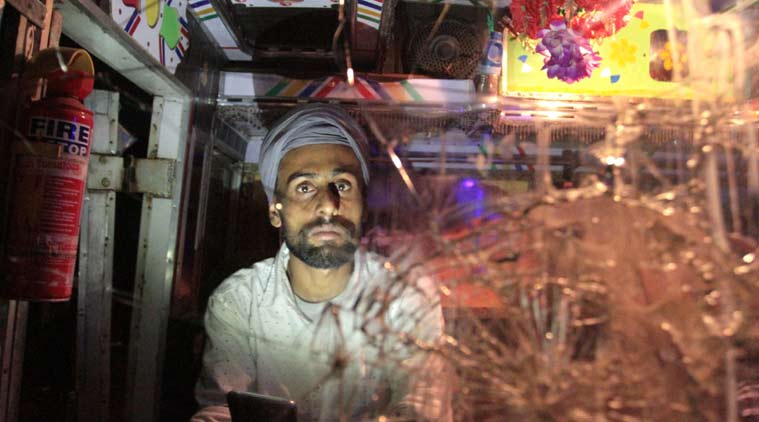 His truck was attacked the night Wani was killed. He is waiting to go home (Source: Express photo by Shuaib Masoodi)
His truck was attacked the night Wani was killed. He is waiting to go home (Source: Express photo by Shuaib Masoodi)
Gurpesh Singh’s life is spent on the roads. A frequent traveller ferrying supplies to Kashmir, he has seen the worst of the Valley. But it is different this time, he says.
He had left his home in Chohla Sahib, Punjab, on July 6 with a truckload of sugar to deliver to Kashmir’s Consumer Affairs and Public Distribution (CAPD) Department and some private distributors in Srinagar. He had promised his sister, his only family, he would be back in a week.
He was still on the road when Hizbul Mujahideen commander Burhan Wani was killed on July 8. The same night, he found himself caught amidst a stone-throwing crowd at Sangam, a village in Anantnag, 45 km from Srinagar. As the flying stones shattered the windshield of his truck, Gurpesh says, he went numb for a few minutes.
Later, he decided to abandon the plans to go to Srinagar, and to return to Lower Munda in Qazigund, the gateway to Kashmir.
Gurpesh spent a week at Lower Munda waiting for the protests to end. When they didn’t, he decided to take the risk and travel at night to Srinagar. Passing by burning tyres and roads blocked by tree trunks and stones, he arrived in Srinagar on the dawn of July 18.
“We are used to travelling at night, but this 90-km journey was scary,” he says. “When I reached Srinagar, it was a big, big relief.”
While he is used to running into protests in the Valley, night times would earlier be peaceful, Gurpesh recalls.
After he arrived in Srinagar, he unloaded some of his cargo at Batamaloo in Srinagar, but it was not easy to find labourers for the job. He then moved to the CAPD yard to unload the remaining sugar bags.
On an average more than 5,000 trucks enter the Valley, carrying rice, fuel, essential items and vegetables. Less than 25 per cent are making their way in now.
Gurpesh has spent the last three days holed up inside the CAPD yard, along with some other truckers. They are from different parts of the country but three days of togetherness has brought them close to each other.
Gurpesh has grown particularly fond of a trucker from Himachal Pradesh. Their days now revolve around their trucks parked at the yard — they cook, relax and sleep in them.
He doesn’t mind that part, Gurpesh says. “We are used to it, but it is difficult to get groceries these days.”
Sitting inside his truck at 6 pm, he also worries about the night. As darkness descends and azaadi slogans reverberate from loudspeakers of mosques, Gurpesh says they start their long wait for dawn.
“The fact is that nobody has harmed us here. But then in an alien land, fear is natural,” he says.
Not able to return home due to curfew and protests, Gurpesh and other truckers also worry about having had no contact with families back home. The cellular services in the Valley are curbed, with only BSNL postpaid connections working.
Talking about his elder sister, the only close relative he has now since their parents passed away several years ago, Gurpesh says, “She must have gone mad waiting for news from me.”
He and the other truckers consider leaving every night, including just the previous evening with a group of protected Amarnath Yatra pilgrims. “But they (the security forces) didn’t allow us to go with them,” Gurpesh says.
Giving up the idea of leaving this night, Gurpesh prepares to go to sleep. “I don’t know why they throw stones at us,” he sighs. “We only bring food supplies for people even in the most difficult of times.”
Gurpesh generally earns around Rs 10,000 for a trip to Srinagar and an equal amount on return. Even if he has to make do with fare for just one way this time, he says he will be back.
“Darr kaisa (what fear)?” he asserts. “I will be here next week with another truck of food supply.”









